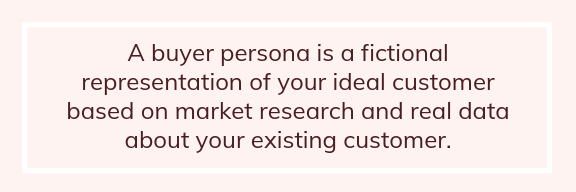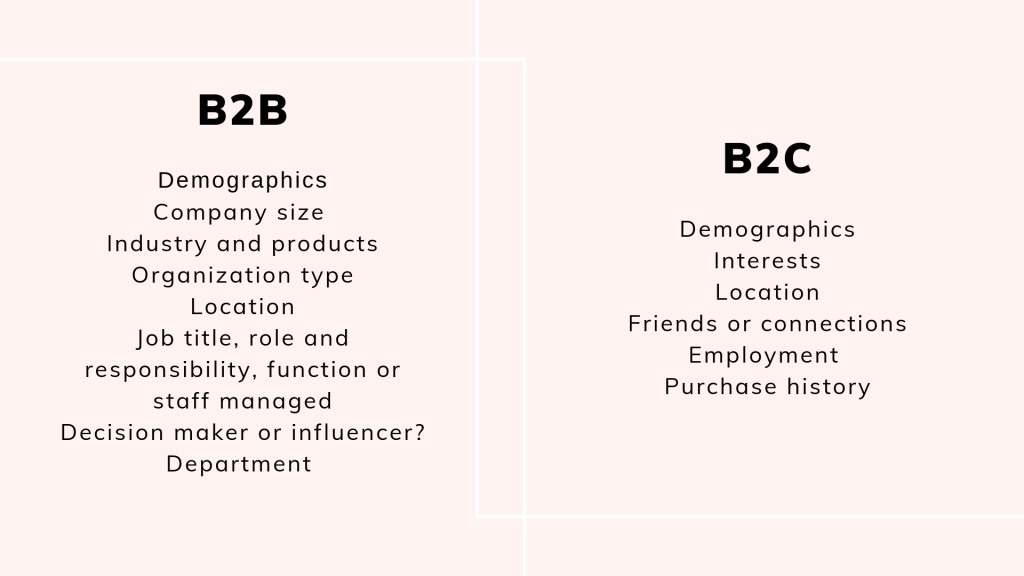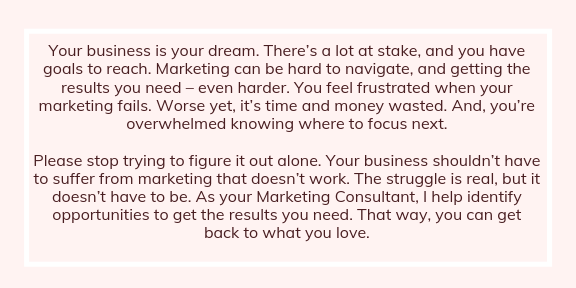
A buyer persona is a phrase that only marketing geeks would know and use. Ugh, I fall in that geek box. A more familiar term is the target audience. But, since this post and my blog are about all things marketing, we’ll use the proper phrase, buyer persona.
Now that we’ve got that straight, are you ready to learn how it will help you attract more clients you love to work with? Great, let’s do it!
What isn’t a Buyer Persona?
First, let’s start with the opposite of what the phrase means. Someone who isn’t a buyer persona is a client you want to repel. Many marketers and business owners get hung up here. The argument? They work hard to attract someone that they can’t repel anyone. But I promise you will want to repel some clients. So, let’s define who isn’t your buyer persona, and we’ll ask that question again.
Someone who isn’t your buyer persona exhibits these traits:
- Has a problem to which you don’t offer a solution
- Haggles with you on pricing and payment terms
- Changes the scope of work constantly
- Doesn’t know what they want or need
- Pays late if they pay at all
- Has demands that seem never-ending
- Submits bad reviews that require a response
You know the ones. Serving this client drains you and your team’s energy and time. But then, when the project ends, it’s a feeling of relief.
Now, imagine a client like this that you’ve worked with before. Do you still want to attract this client or more like them? Well, I didn’t think so!
When your marketing doesn’t appeal to your buyer persona, you can attract this client. While you may be personal friends outside of work, something about the business relationship isn’t a match. Recognize it and move on.
What’s a Buyer Persona?
Your day starts with a smile when you see a meeting scheduled with this client. You look forward to it, even if the project itself is a challenge. That makes working together easy, and it feels like a natural fit. And together, you bring great things to life. You’re proud of what’s accomplished, and so are they. Afterward, they pay on time, give a glowing review, and recommend their colleagues to work with you too. Can you imagine this client, or maybe you have a few like this? Keep that image close in your mind.

This representation is in the form of a story. Why? We remember and relate to stories better and easier than categories, buckets, or profiles.
Why do you need a Buyer Persona?
Online it’s easy to hide behind the computer screen. Real people turn into abstract terms like visitors, browsers, or lurkers. You then forget that each one is a real person with a beating heart with needs, wants, and problems to solve.
Unfortunately, a lot of copy and messaging online lose this focus. Instead, it morphs into a mere sales pitch that attracts a client that doesn’t fit into the category of being ideal. Sound familiar?
When you can picture that ideal client in your mind, you’re talking to one person and not to hundreds or thousands — your messaging shifts from broadcasting and amplifying to targeting a niche segment. Most of us are afraid to target our marketing efforts. But, the saying is true, “there are riches in the niches.”
If the person on the other end of the digital device doesn’t feel something or relate to the marketing message, it won’t move them to take action. But, on the other hand, copy that’s written for the buyer persona gives them that ah-ha moment where they say, “Yes, this is for me. They get me.” That’s when your brand story connects with the right audience, and they take action.
And for the not-so-ideal client, they say, “this isn’t quite right for me.” So they move on, and we’re good with that too.
How do you Create a Buyer Persona?
It seems like an impossible task, but with these easy-to-follow steps, you’ll create one, two, or three in no time.
1. Conduct Research
Research seems like a scary task. I agree. It’s because we envision spreadsheets of data with no end in sight. Or, it looks like an empty canvas with no direction on where to get started. That’s okay. I’ve gotcha covered on this one.
First, what are you trying to learn through your research? You want to identify the demographics, interests, lifestyle, and behaviors of your ideal client. Now, this will be slightly different if you’re a B2B versus B2C business. Here’s a snapshot of how that looks.

Now that you know what you’re trying to find out. How do you gather this information?
Talk to your colleagues. While in your role, you may or may not directly interact with customers, so you need to talk to those that do. They can be the best source of information. Your sales team or the customer service team can give insight into what you need. Be prepared with specific questions when you meet. Then as you develop the buyer persona, seek their input throughout the process and refine the story.
Analyze your competitor’s social media profiles or other review websites. Maybe you’re a new business, or you don’t have a team of colleagues to tap into. And even if you do, I recommend not skipping this research step. It adds an extra layer of insight that can shape your result.
Here, you’re looking for comments, attitudes, and perceptions from other similar clients. Capture words, phrases, and ideas you might not have thought of before. Compile a list of what you find.
Conduct a survey. If you already have a client base, go right to the source. You can create a survey using several platforms such as SurveyMonkey. In addition, some social media platforms provide a survey tool that’s quick and easy to use. Whatever method works for you, you’ll gain valuable information from your audience.
Interview or talk to existing clients. If you can get more one-on-one time with current clients, use this time to learn more about them, their problems, why they love working with you, etc. You can ask more in-depth questions and get answers to what you’re missing from the research you’ve already done.
You’ll want to talk to clients or past clients that fall in the “not ideal” bucket. With this group, find trends that identify them as not ideal. But note, this isn’t an exercise to research how you can change what you offer or fix the partnership to make them an ideal client. Instead, you’re trying to learn why they aren’t an ideal client from their perspective and yours.
2. Create a Profile
From the research gathered, fill in as many answers as you can from the profile list above. Then, essentially, compile your data. Don’t worry about how it looks. You want to discover trends and consolidate the information.
Stay away from broad categories. For example, you want to pick a main age category such as 25-34 years old. 18-65 is too broad and doesn’t narrow it down enough to identify an individual. An 18-year old has different wants, needs, and life goals as compared to someone at 65. Pick a narrow category. Same with male or female. Pick one. Remember, this creates your story, and it won’t be perfect. The goal is to create one that represents your ideal client.
If you’re a B2B company, Hubspot has a helpful buyer persona tool that walks you through a set of questions to create a profile. Even if you’re a B2C company, this helps identify the types of insight you need to make the profile. Give it a try!
3. Identify Similar Problems or Pain Points
Your research should reveal a trend in problems, challenges, or pain points your ideal client faces. Start by making a list.
When you’ve got that list, now prioritize it. Which ones occur more often? Which ones caused clients to take action and call you or work with you? Which ones do you have the best solution(s) for?
Notice how the problem made your buyer persona feel? Words like overwhelmed, helpless, and frustrated are a few that come to mind that is typical. Note these feelings on another list.
4. Discover their Objective
While every business wants to sell something or provide a service, this is about them, not you. So, you’ll want to focus on their objective.
Identify one and be specific, if possible. For example, maybe it’s to reach a revenue goal of $10M. While there are always other goals and objectives, start with the primary one that motivates the buyer persona to decide and take action.
5. Curate the Story
Now, with everything you’ve done up until now, piece together all of the information. If you were reading a bedtime story to a child, how would it sound? Hopefully, not scary but conversational, relatable, and memorable. Incorporate words, phrases, and language your ideal client uses.
Examples help, so here’s what one might look like for Sprout Marketing:
Melissa is a single, thirty-one-year-old small business owner in Charlotte, NC. After spending her twenty’s working at a yoga studio, she started her own business from the ground up with passion and a dream that blossomed from there. A year later, she expanded into another location across town. It amazes her still at how far she’s come in such a small amount of time. Hard work, determination, and grit kept her moving forward. Plus, her customer-first approach garnered her the word of mouth and referrals her business needed to get started. Business is good, but growth is slow and steady now. To get to her goal of adding new services to her studio, she needs an additional 50 customers per month. She once hired someone to perform SEO on her website with no results. Marketing is on her to-do list, but she’s overwhelmed with where to get started. She knows she needs help, but who can she trust? After all, her dream is at stake.
Can you picture Melissa or imagine someone like her? Remember, she’s not a real person but a representation of an ideal client – a buyer persona. Creating a message and marketing that targets Melissa is easier than throwing an arrow and hitting a broad audience.
How long should your story be? As long as it’s needed to address the main points to clarify your message and improve your marketing. This example buyer persona story could easily be longer and provide further details on what she reads, social profiles she uses, interests, and more.
How Many Buyer Personas do you Need?
A simple answer is at least one. I’ve created up to six for a B2B organization. And a company like Amazon could have hundreds. You need to have as many as you need to identify the unique client base you serve and the solutions you offer to solve their problem.
If you’ve created more than one, list them in order by priority and assign a percentage up to one hundred, representing how much of the market you serve with that buyer persona. That helps you focus on each one in order of importance.
As you create marketing and messaging, you’ll want your efforts and channels to align with the priority you’ve assigned each one.
How do you use a Buyer Persona?
Now that you know who you’re speaking to through your marketing and digital efforts, how do you use it successfully? Start by reviewing your most important marketing piece.
Read your buyer persona, then read the marketing piece. Does it sound like it was written for that specific person? Does it identify their challenge, their goal, how they feel, and offer a solution to help them overcome the obstacle?
Imagine the buyer persona reading that marketing piece. Even better if you can have an actual client read it. How does it make them feel? Do they take action? If not, it’s time to rewrite the copy.
Here’s an example of a buyer persona story that speaks directly to Melissa.

Finally, move on to reviewing and revising the rest of your marketing. With each new piece, refine it to be better than before.
You’re never done working on your buyer persona. It’s a living piece that needs tweaking regularly. Your business will grow and change, and so will your buyer persona. So anytime your marketing needs a refresh, start with the buyer persona.
Leave me a comment and let me know if you have any questions.
Ready, set, grow!
All my best,


Leave a Reply